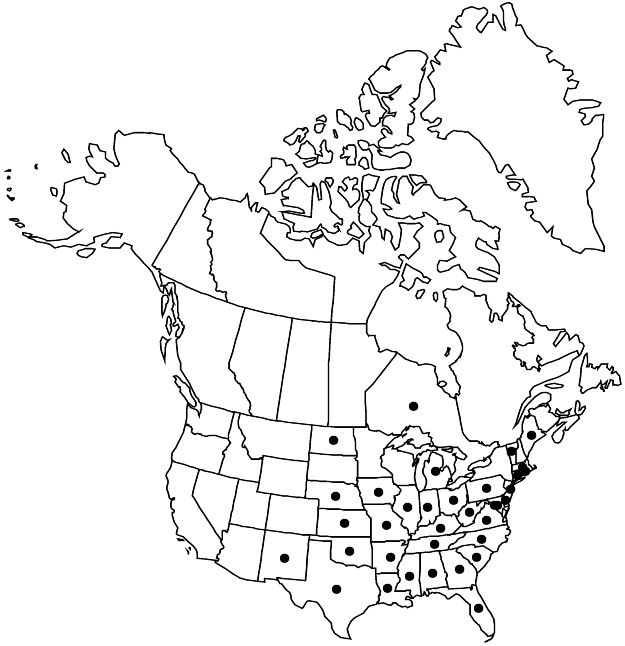Viola palmata
Sp. Pl. 2: 933. 1753.
Plants perennial, acaulescent, not stoloniferous, 6–50 cm; rhizome thick, fleshy. Leaves basal, 2–3, ascending to erect; stipules linearlanceolate, margins entire, apex acute; petiole 1–20 cm, glabrous or pubescent; earliest leaf-blades unlobed, mid-season blades 3–9-lobed, lobes sometimes appearing petiolate and sometimes further lobed; earliest leaf-blades reniform to ovate, mid-season blades with middle lobes usually ovate or elliptic to widely obovate, sometimes narrowly elliptic, narrowly ovate, lanceolate, or spatulate to narrowly obovate, lateral lobes elliptic, obdeltate, or spatulate to falcate, smaller lobes similar, 1–14 × 1–10 cm, base truncate to cordate, margins serrate or entire, usually ciliate, apex acute, rounded, blunt, or obtuse, surfaces glabrous or pubescent throughout or along veins. Peduncles 3–13 cm, glabrous or pubescent. Flowers: sepals lanceolate, margins ciliate or eciliate, auricles 0.5–1 mm; petals violet on both surfaces, lower 3 white basally, lower 3 and upper 2 sometimes purple-veined, lateral 2 bearded, spur sometimes bearded, lowest 15–25 mm, spur white, gibbous, 2–3 mm; style head beardless; cleistogamous flowers on prostrate to ascending peduncles. Capsules ellipsoid, 5–15 mm, glabrous. Seeds beige, mottled to bronze, 1.5–2.5 mm. 2n = 54.
Distribution

Ont., Ala., Ark., Conn., D.C., Del., Fla., Ga., Ill., Ind., Iowa, Kans., Ky., La., Maine, Mass., Md., Mich., Miss., Mo., N.C., N.Dak., N.J., N.Mex., Nebr., Ohio, Okla., Pa., R.I., S.C., Tenn., Tex., Va., Vt., W.Va.
Discussion
N. L. Gil-Ad (1997) presented evidence based on seed coat micromorphology that some plants known as Viola palmata are hybrids between plants with lobed and unlobed leaves and believed the type specimen to be hybrid in origin. He chose not to recognize the name V. palmata, choosing instead to recognize V. triloba. If the type specimen does represent a hybrid, Gil-Ad would be correct in recognizing V. triloba. Because the purity of the type specimen cannot be ascertained, we consider V. palmata the most appropriate name for this taxon. We acknowledge the presence of hybrids between lobed and unlobed plants; such hybrids obscure lines of demarcation. Some herbarium specimens may represent such hybrids; we feel most do not.
L. E. McKinney (1992) described the nomenclatural history of Viola palmata. Homophylly versus heterophylly differentiates V. palmata from V. subsinuata, the homophyllous violet most often called V. palmata. We know that the taxon described by Linnaeus was heterophyllous, with some undivided leaf blades.
Varieties 2 (2 in the flora).
Selected References
None.
Key
| 1 | Petioles, leaf surfaces, and peduncles usually pubescent, rarely glabrous; apex of middle leaf lobe acute; plants of dry to mesic habitats. | Viola palmata var. palmata |
| 1 | Petioles, leaf surfaces, and peduncles usually glabrous, rarely pubescent; apex of middle leaf lobe rounded, blunt, or obtuse; plants of wet ground. | Viola palmata var. heterophylla |
"thick" is not a number.